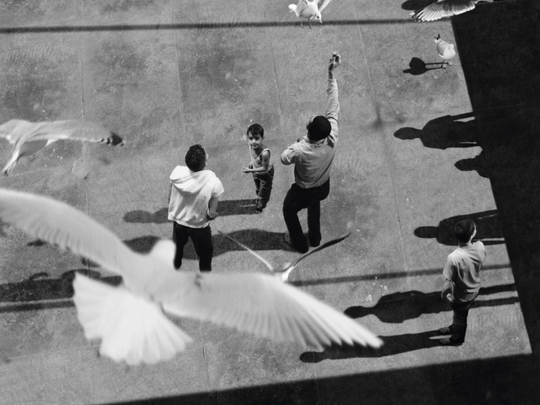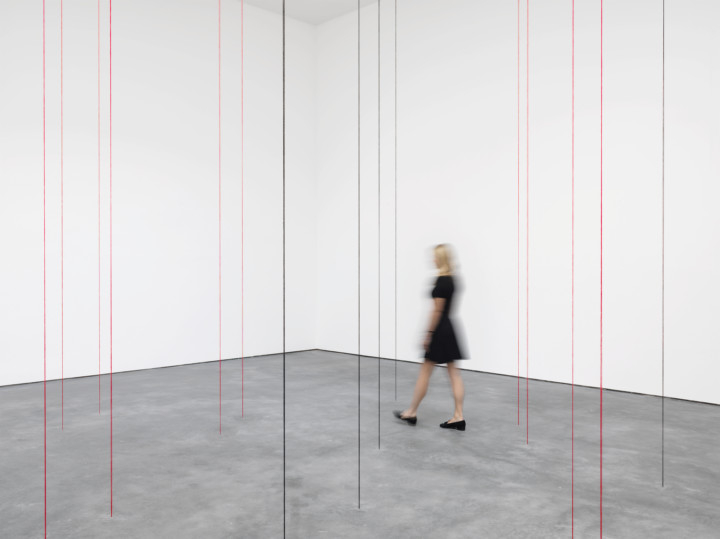
NYU Abu Dhabi Art Gallery’s autumn exhibition, Ways of Seeing, has been curated by internationally acclaimed curators and contains works from some of the most recognised names in the art world. However, the exhibition is actually all about the viewer and their opinion.
“The whole point of the show is to put the viewer’s perspective first. Each of us are our own authority on art, whether we know it or not. We are an authority on how we look at art and this exhibition returns that authority to you,” said Maya Allison, Executive Director of the gallery and Chief Curator at NYU Abu Dhabi, as she joined the Weekend Review for a tour of the exhibition.
The curators of the exhibition, Sam Bardaouil and Till Fellrath, founders of the multi-disciplinary curatorial platform Art Reoriented, Chairmen of the Montblanc Cultural Foundation, and Affiliate Curators at the Martin-Gropius-Bau in Berlin, and first external curators to collaborate with the gallery, have created a show that is all about the act of looking.
Bardaouil and Fellrath have taken the unusual step of presenting 41 works by 26 very artists including, Salvador Dali, Cindy Sherman, Andreas Gursky, James Turrelle and Hassan Sharif, just to name a few, spanning a variety of media, from painting, sculpture and photography to sound, film and installation.
“A typical way for a curator to work would be to take a subject…and then it gives you an expert tour on that. This exhibition is not about a particular art form or style in the region. It is about how art asks us to look at it and how we look at art. This is something that we all do and we become conscious of that act,” said Allison.
The curators have also taken the unconventional approach of providing minimal wall labels for each piece, and withholding details. Forcing the onlooker to get their own first impressions and ideas of what they are looking at.
Alicja Kwade’s Kohle piece, the first work in the exhibition, resembles a block of bricks coated in gold. In fact, the Polish artist’s installation is commercial coal covered in gold.
“What we think of a humble medium, coal, presented as a valuable precious sculpture. So immediately there is a question between what does value mean, in art, in commodity, in objects? Gold is considered as valuable, coal is not,” said Allison.
If the coal connection is not made, the viewer could walk away with a completely different perspective than perhaps what the artist intended.
“This is a very interesting moment when you realise that we all bring our own cultural perspective to what we are looking at. It is going to look very different to a Polish person, because in Poland the coal would be recognisable,” said Allison.
Anyone who is interested to learn more about the pieces can receive a brochure with more details, which is highly recommended as the information can help provide yet another perspective.
Three large gripping photographs from the Hermitage series by Thomas Struth of a colourful crowd of visitors in a museum looking at artwork draws the viewer into the images and puts them in the same position as Struth’s subjects.
“They [the audience in the photograph]are doing what we are doing. You see all these different expressions, there are many different reactions as they question, or enjoy, dislike, scowl, many different types of reactions to what they are seeing,” said Allison.
Struth’s work is perfectly placed in front of one the show’s most thought-provoking and interactive installations, Gustav Metzger’s To Crawl Into, creating the impression that the photograph’s audience are actually reacting to this work.
The piece is a large black and white photograph, placed on the ground, of Jewish men, women and children being forced to scrub the streets of Vienna, shortly after the annexation of Austria into Nazi Germany, in 1938, as people standby and watch. The image is completely covered by a yellow fabric, forcing the observer to see the work by getting under the fabric and crawl over the picture.
This, Allison said, is because the artist feels that horrific events in history are too difficult to look at all in once.
“As you are looking at it, you will realise that you too are on your hands and knees. It’s a very different way of looking at it from a typical museum encounter. The idea is provocative, the only way to see the piece is to be the piece, because the piece is you crawling through it,” said Allison.
Again, if the viewer does not grasp exactly what they are looking at, they can walk away with a completely different impression.
A second piece from Metzger’s Historic Photographs series, is placed on an adjacent wall however, you may not see it until the end of the exhibition depending on whether you turn right or left in the hall, which itself may provide yet another dimension to the spectator’s emotions about To Crawl Into.
Titled To Walk Into, this time an enlarged photograph hung on a wall, of a moment from the Al Aqssa Massacre, which took place in occupied Jerusalem on October 8, 1990, shows armed Israeli soldiers standing over Palestinians who are lying on the ground. The image is covered by a curtain and to see it the viewer has to stand behind the curtain, very close to the image.
By forcing the viewer to experience crawling and standing tall, the audience take the place of the oppressed and oppressor. Metzeger’s work also raises question of whether parallels can be drawn between what happened at the hands of the Nazis, what is happening at the hands of the Israelis and the ongoing cycle of violence.
All the while, Struth’s audience is keeping an eye on both pieces in the backdrop.
The travelling exhibition, which first opened at ARTER — Space for Art in Istanbul and was later adapted for the Boghossian Foundation — Villa Empain in Brussels, has kept core works from its previous presentations and features new artists and artworks that can be more relevant to people in this region.
“The curators believe part of the way we see has to do with where we are. Not just culturally but physically,” said Allison.
Allison said while the Brussels show contained issues such as racism and imperialism, which are relevant to Belgium, the Abu Dhabi exhibition touches on orientalism and representation of Dubai.
One of the new additions to the show is Lateefa Bint Maktoum. Two photographs, Observers of Change 4 and Oral Tradition, draw the viewer’s attention to past, present and future by showing individuals dressed in traditional Emirati clothes looking at Dubai in the background.
“Foreground is the act of looking but also the distance potentially between tradition and modernity, distance between the natural landscapes,” said Allison.
If you take a few steps to the right from Observers of Change 4, Andreas Gursky’s massive photograph of Dubai World 1, a seemingly clear shot of Dubai World islands, can be seen on a wall in the distance. The strategic positioning can give the viewer the same position as bint Maktoum’s subject, who is looking at Dubai’s skyline from a distance.
As with other works in the exhibition, a closer look at Gursky’s piece reveals other truths. The photograph is not one single shot of the islands, it is several images masterfully woven together.
A number of pieces in the show, such as Fred Sandback’s minimalist installation of 22 lengths of black and red acrylic yarn stretched between the ceiling and the floor, which you are encouraged to walk through, will make the viewer second guess their eyesight.
“As you walk through it, you see how your body feels in the space. He has created a lot of things that our eye is programmed to read as edges, like an edge of a wall or a person, it’s just strings. Some people get seasick walking through it and others don’t feel anything,” said Allison.
Les yeux surréalistes by Salvador Dali, a leading figure in the Surrealist movement, returns the spectator’s gaze and directs it towards the artwork with his statue of eyes.
One of the pieces that perhaps takes longer to fully grasp is David Claerbout’s video installation, The Algiers’ Sections of a Happy Moment. At first glance it may seem like a random selection of photographs of people however, it gradually becomes apparent that it is a frozen moment in time from multiple angles. The piece consists of six hundred remarkable photos, selected from fifty thousand, which some how expands or contracts the perception of the passage of time.
The exhibition also has a couple of surprises evolving around Picasso and a box of Milky Way chocolate box, which are best left to be experienced.
“This exhibition kind of gives you every possible way that people think of defining art. Whether from traditional painting to complete and total minimalist,” said Allison.
Sarvy Geranpayeh is a writer based in Dubai.
Ways of Seeing will run at NYU Abu Dhabi Art Gallery until November 17.











